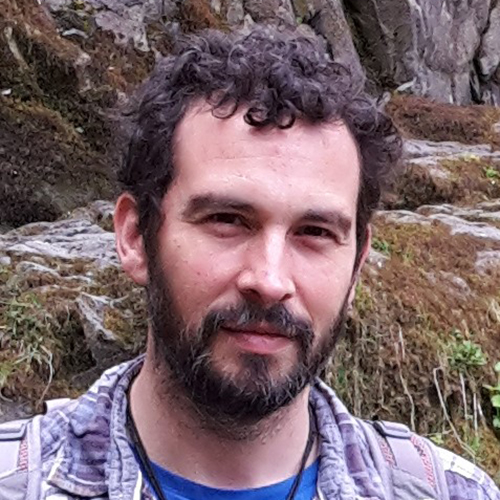Key details
Dr Xacobe C. Cambeiro
Senior Lecturer in Chemistry
Dr Xacobe Cambeiro joined the School of Science at Greenwich in February 2021, when he accepted a position of Senior Lecturer in Chemistry. After graduating with a BSc(Hons) in Chemistry from the University of Santiago de Compostela, in his native Galicia, he moved to Barcelona to work towards his PhD under the supervision of Prof Miquel A. Pericàs. After defending his thesis, he worked as a post-doctoral researcher at the Institute of Chemical Research of Catalonia (ICIQ, in Tarragona), Queen Mary University of London (QMUL) and the University of Manchester. He returned to QMUL to take over his first academic position as a Lecturer in Organic Chemistry, where he stayed until moving to the University of Greenwich.
Dr Cambeiro’s research expertise covers a wide range of areas within the general field of homogeneous catalysis for the development of new methods for organic synthesis. Thus, he has worked on the design of new ligands for asymmetric metal catalysis, catalyst heterogenization using polystyrene resins, continuous flow systems for enantioselective synthesis and new organometallic catalytic systems for C-H activation of arenes using Pd, Au or Ru catalysts. Since recently, Dr Cambeiro leads research programmes on photocatalysis and artificial photosynthesis applied to synthesis, aiming to use visible light as the source of energy to promote chemical reactions. In this area, he has worked on photocatalytic transformations of electron-poor alkenes, including transfer hydrogenation and hydroalkylation. Also, he is developing new catalytic systems capable of using water as an environmentally friendly reagent for reductive transformations of alkenes. He has recently secured a New Horizons grant from EPSRC to fund the latter research programme.
Besides his research activity, Dr Cambeiro was accredited in 2020 as a Fellow of the Higher Education Academy and has extensive experience in teaching organic chemistry in an engaging manner, putting the focus on understanding concepts rather than memorising reactions. Also, Dr Cambeiro has a long-standing interest in improving communication of science to the general public and scientific literacy in general and has participated in a variety of outreach activities.
Research / Scholarly interests
Dr Cambeiro’s research is oriented to the discovery of new reactions for organic synthesis, using catalysis to achieve cleaner, more efficient, selective and environmentally benign reactions. Currently his research centres on the utilisation of visible light as a promotor for chemical reactions. By using the energy of light, we can perform thermodynamically disfavoured reactions (i.e. with a positive Gibbs free energy), which would be impossible under normal conditions. He is applying this strategy to developing reductive transformations of alkenes, using water as a cheap, abundant and environmentally friendly chemical reagent instead of the usual, highly reactive fossil-derived reductants such as hydrogen and metal hydrides.
Recent research projects include the photocatalytic transfer hydrogenation of cinnamate derivatives and photocatalytic, regioselective hydroalkylation of aromatic-substituted alkenes. Currently, he is working on the combined use of photocatalysis and transition metal catalysis for the discovery of other useful transformations of alkenes with water as the source of hydrogen atoms, a project recently chosen for funding by the UK Engineering and Physical Sciences Research Council.
Key funded projects
Artificial photosynthesis strategies for synthesis: Combined photoredox and transition metal-catalysed transfer hydrogenation of C-C multiple bonds
EPSRC New Horizons Grant
Combined use of photocatalysis and transition metal catalysis to achieve more environmentally sustainable methods for the transfer hydrogenation of alkenes, particularly using water as the source of hydrogen atoms.
Light-promoted, iron-catalysed formal hydrogenation of organic compounds: New mechanistic manifolds for reductive functionalisation of multiple C–C bonds (LIONCAT)
European Commission Marie Sklodowska Curie Fellowship
Use of iron catalysis and photocatalysis to achieve light-promoted hydrofunctionalisation reactions of alkenes.
Au(I)-catalyzed decarboxylation in direct decarboxylative C–H arylation (AuPdCHAryl)
European Commission Marie Sklodowska Curie Fellowship
Development of new cross-coupling methodologies for the construction of biaryls, important fragments in many bioactive compounds, using Au catalysis.
Recent publications
Article
Zhang, Jinlei , Selmi-Higashi, Elias, Zhang, Shen, Jean, Alexandre , Hilton, Stephen T. , Couso Cambeiro, Xacobe , Arseniyadis, Stellios (2024), Synthesis of CHF2-containing heterocycles through oxy-difluoromethylation using low-cost 3D printed PhotoFlow reactors. American Chemical Society (ACS). In: , , , . American Chemical Society (ACS), Organic Letters ISSN: 1523-7060 (Print), 1523-7052 (Online) (doi: https://doi.org/10.1021/acs.orglett.3c03997).
Larionova, Natalia A. , Miyatake Ondozabal, Jun, Smith, Emily G., Couso Cambeiro, Jacobo (2021), Letter: A photocatalytic regioselective direct hydroaminoalkylation of aryl-substituted alkenes with amines. American Chemical Society. In: , , , . American Chemical Society, Organic Letters, 23 (14) . pp. 5383-5388 ISSN: 1523-7060 (Print), 1523-7052 (Online) (doi: https://doi.org/10.1021/acs.orglett.1c01715).
Selmi-Higashi, Elias , Zhang, Jinlei, Cambeiro, Xacobe C., Arseniyadis, Stellios (2021), Synthesis of α-Difluoromethyl aryl ketones through a photoredox difluoromethylation of enol silanes. American Chemical Society. In: , , , . American Chemical Society, Organic Letters, 23 (11) . pp. 4239-4243 ISSN: 1523-7060 (Print), 1523-7052 (Online) (doi: https://doi.org/10.1021/acs.orglett.1c01177).
